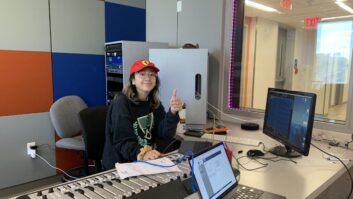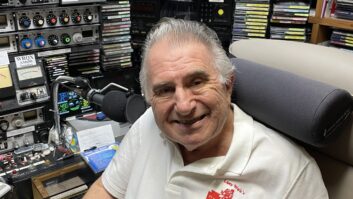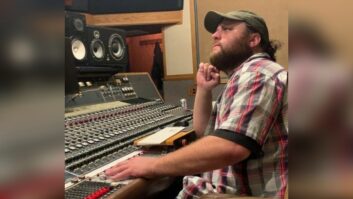Salem Omaha rebuilds
Feb 1, 2008 12:00 PM, By Mike Shane, CBRE, and Chriss Scherer, editor
Studio A, which can be used for production or on-air on any of the stations, looks into studio C.

Master production looks into the KGBI air studio.
The master control racks house equipment that is accessible to operators as needed.

Studio C is primarily used as a talk studio and for voice tracking.

Studio A looks into studio C where Roger Manning voice tracks.

The KGBI air studio and the production studio are stand-up consoles.

Nick Buras edits an audio file in air studio B.

The engineering racks house the satellite receivers and Logitek and Enco servers.

Salem Communications owns three stations that serve the Omaha market: KCRO-AM, KGBI-FM and KOTK-AM. Each station has a history that goes back many years, and the stations’ previous studios had seen a major part of that history. Salem acquired the three stations in 2004 and 2005, and it was known early on that new facilities were a necessity.
Before the rebuild, the three stations were operating from two studio locations. Each location was built to house one stand-alone station. The newer facility, suite 202 in the Burt Street Professional Building, was built in 2004 for KCRO, which had occupied its previous facility in midtown Omaha for 25 years. The all-analog facility served the talk radio format with three studios.
On the other hand, KGBI’s former facility was not so new. Located on the near-downtown campus of the previous owner, Grace University, the facilities dated to the 1970s, while the building itself dated to at least the 1950s.
Before Salem bought KGBI and KCRO, the FM was noncommercial and the AM had one sales person. Salem added a sales staff, which needed office space. The first sales office was established � unsuccessfully � in KGBI and then shoehorned into the offices at KCRO. Because of lease considerations, the two stations continued to operate in their separate facilities.
Then Salem bought KOTK in late 2005. This third station needed a home. Knowing that a rebuild was certain, KOTK was operated out of the same control room as KCRO. While not an ideal situation, Salem made it work while waiting for space to become available at the Burt Street Professional Building.
When the adjacent suite, suite 201, was vacated in June 2006, planning and design began. The entire project was divided into three phases. Phase one was to clear the new space so construction could begin. Although it was known that the new space would be available, prior access to the space was limited. Once Salem had access, the biggest labor-intensive part of the project began.
Major cleanup
A previous tenant in the new space was a division of AT&T, which at one time occupied the entire second floor. Chief Engineer Jim Leedham discovered a great deal of old wiring left behind in the ceiling. While it was tempting to simply cut the old cable out of the way and start fresh, Leedham took the precaution to ensure there were no live circuits still in place. This careful step proved to be a wise course of action as some in-use cables were found.
Construction began in December 2006. The new studios were located in this expanded area.
Phase two was a logistical move to temporarily relocate the office and sales staff from suite 202 so it could be cleared. Fortunately, alternate office space was available in the same office building. Once suite 202 was cleared, phase three kicked in. New offices and a new reception area were constructed and the two suites were merged into one larger space. The final step was moving the office and sales staff back from its temporary location. The new facility maintained its designation as suite 202.
The AM stations were cut over together in late March 2007, and the FM moved in almost two months later. While a studio rebuild project is a significant undertaking on its own, KGBI also built a new transmitter site at the WOWT-TV facility in northwest Omaha. For the FM, the studio and transmitter site cut over were done simultaneously, which simplified the transfer. The old studio fed the old transmitter while the new studio fed the new transmitter. Turn one off and turn the other one on. The old transmitter site serves as a back-up.
Six studios now serve the three stations. Five of the studios are fully equipped with studio equipment, while the sixth is a talk studio with mics and telephone control interface. The heart of the facility is centered around a Logitek Audio Engine system with Remora surfaces and an Enco DAD automation system.
To the future
As much as possible, the audio paths are digital. The Enco and Logitek systems are interconnected digitally. The Enco audio servers also provide an analog output to the Broadcast Tools switchers, which also receive an analog feed from the Logitek Audio Engine. This provides the stations a backup path in case of a router failure. In time, the analog elements can easily be replaced with digital paths.
From the Broadcast Tools switchers, the program chain feeds a limiter and is conveyed to the various transmitter sites through telephone company leased lines. The AMs use 8kHz analog audio loops, while the FM has a nailed-down ISDN service. One disadvantage of the Burt Street studio site is that it does not have a line-of-sight RF path to any of the transmitters.
The AM stations receive a great deal of satellite-delivered programming, so there are a host of satellite receivers in the engineering/server room. Receivers include four Wegener Unitys (a staple in Christian broadcasting), two Starguides for news/talk KOTK, and space for the awaited Ambos satellite FTP (S-FTP) receiver. This smaller rack room also houses servers for the Enco and Logitek systems.
Personnel from Salem corporate and contractors performed most of the studio buildout while Leedham was busy building the new transmitter and also dealing with a major theft at one of the AM sites about a month before the AMs were to move into the new studios.
The three stations now enjoy a new-found level of redundancy and signal routing flexibility, not to mention added peace of mind. The old facilities were locked in time in a stand-alone configuration, while the new facilities should provide countless options to accommodate future changes and expansion.
Equipment List
360 Systems Short Cut
Adobe Audition
Air Tools 6000
APC 1200 UPS
Aphex 320A Compellor
Broadcast Tools SS16 x 4
Cisco Systems 3750
Comrex Hotline, Matrix, Nexus
Crown D-75A
Dell Optiplex 745
Electro-Voice RE-20
Enberg BA-6
Enco DAD Pro
Graham Studios furniture HHB Burn IT Plus
JBL Control 5
Logitek Remora 18, Remora 10
Lucid Gen x192
Marantz PMD 340
Rolls RS80
Sage Endec, Receiver
Sony MDR-7506, MDS-E58
Stanton C-500
Starguide II, Starguide III
Symetrix 528E
Teac W-600R
Telos 1×6, 2×12, One by One, Zephyr Xstream
TFT 911
Unity satellite receivers
Shane is operations manager of KCRO-AM and KOTK-AM, Omaha, NE. Salem Omaha Chief Engineer Jim Leedham also contributed to this article.
For additional photos, go to page 2.
Salem Omaha rebuilds
Feb 1, 2008 12:00 PM, By Mike Shane, CBRE, and Chriss Scherer, editor
KGBI morning host Roger Manning voice tracks a weekend program in studio C.
Photo by Scott Foster

The production studio looks into the KGBI air studio.
Photo by Scott Foster
Brooke Winters at work in the production studio, which is also used for voice tracking.
Photo by Jim Leedham


Tie lines are terminated on Krone block behinds the engineering racks.
Photo by Jim Leedham
Talk studio B is sandwiched between air studio B and talk studio A.
Photo by Jim Leedham


Except for the room dimensions, air studio A and air studio B are nearly identical.
Photo by Jim Leedham
Talk studio A is used to record talk shows and voice tracks.
Photo by Jim Leedham


The floor plan of the new facility.
Click on image to enlarge.











